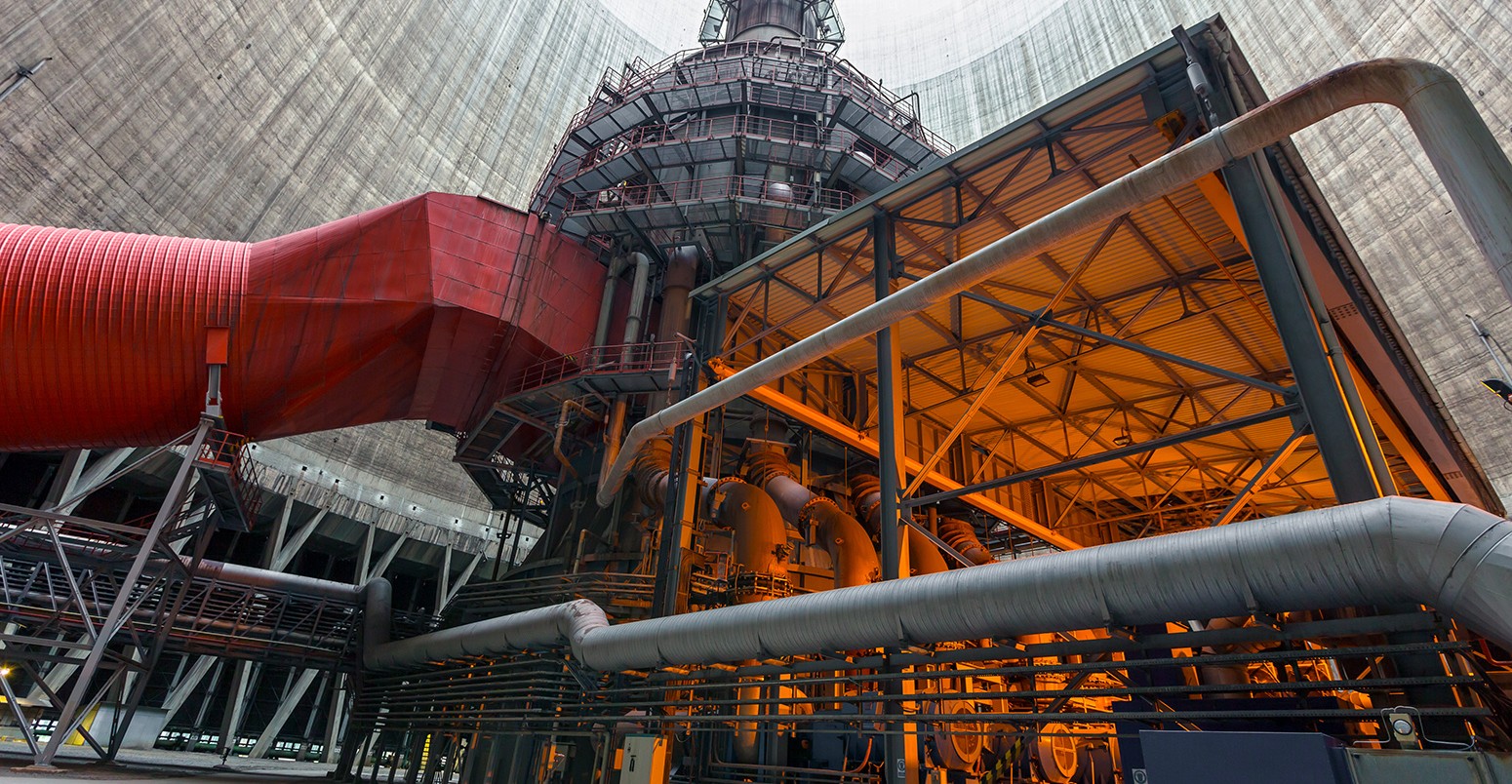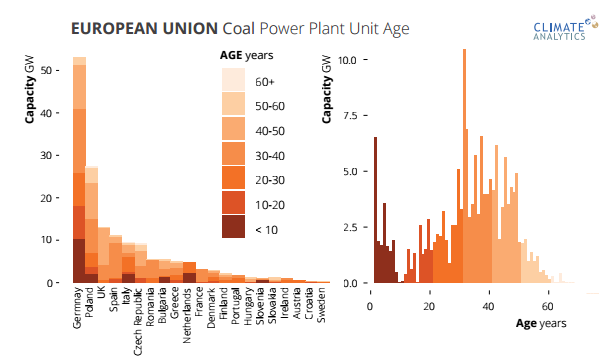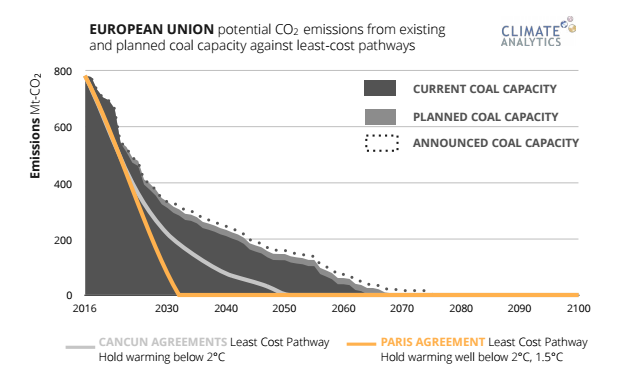
Mapped: EU coal plants ‘should all close by 2030’
Multiple Authors
02.09.17Update: as of 31 March 2025, this map is no longer available.
EU countries should close all of their coal plants by around 2030 if they want to stick to the Paris Agreement on climate change.
This is the conclusion of a new report by research non-profit Climate Analytics. The cheapest way to meet Paris targets is to replace EU coal power with renewables and energy efficiency, it says.
This 2030 timeline is in line with planned phaseouts in the UK, Denmark, Finland and Portugal. The Netherlands and France are also discussing an end to coal. For Germany and Poland, however, a 2030 phaseout would be a significant challenge.
Carbon Brief has mapped the year when each individual coal plant across the EU should close, in order to stick within this overall, Paris-compliant 2030 timeline, according to the new analysis.
Paris goal
The Paris Agreement on climate change aims to limit warming to well-below 2C above pre-industrial temperatures and to pursue efforts towards a 1.5C limit. The Climate Analytics study takes this to mean an 85% chance of staying below 2C and a 50% chance for 1.5C.
To meet this goal, the whole world will need to stop using coal power by 2050, the study suggests. Only plants that fit carbon capture and storage (CCS) equipment would be able to stay open.
Paola Yanguas Parra, a lead author of the report, said in a statement:
“We find the cheapest way for the EU to make the emissions cuts required to meet its Paris Agreement commitments is to phase out coal from the electricity sector, and replace this capacity with renewables and energy efficiency measures.”
The last unabated coal-fired power station in the EU should close by around 2030, the report says. This is much earlier than the expected closure dates of many existing coal plants. Some EU member states are still building new schemes.
Under the Paris deal, the study says EU coal plants should emit no more than 6.5 billion tonnes of CO2 (GtCO2) by 2050. If no action is taken and these existing coal plants are allowed to run until the end of their normal life, then the EU will emit 85% more than this limit.
There’s a lot going on behind this coal phaseout timeline. First, it is based around the assumption that meeting the Paris temperature limits is actually possible. This is far from certain. To do so will probably require so-called negative emissions technologies to suck CO2 from the air.
Second, the coal timeline is the result of a combination of uncertain modelling techniques. You can read more about how this was done in the Climate Analytics study. For now, let’s take the timeline as a given.
Closing coal
At present, there are more than 300 coal plants operating across the EU. Germany and Poland account for half the total, as the chart below shows. There are no coal plants in Belgium, Luxembourg, Malta, Cyprus, Estonia, Lithuania or Latvia.

Coal plant capacity and age structure across the EU. Left: capacity in each member state. Right: age structure of the EU fleet. Source: EU Coal Stress Test, Climate Analytics.
Most EU coal plants are nearing the end of their normal life, with many in excess of 40 years old. However, there is also a group of newer coal plants built within the past 10 years, particularly in Germany, Poland, Italy and the Netherlands.
Newer plants could continue running into the 2050s or 2060s, given the average 46-year life of a coal unit. Unless these plants are retired early, the report says “…emissions will be locked into the system longer than what would be consistent with the EU’s GHG emissions reduction targets”.
The chart below shows CO2 emissions from EU coal plants compared to emissions pathways compatible with the Paris Agreement or a less ambitious 2C goal.

Emissions from current, planned and announced EU coal capacity (grey and black areas) compared to a Paris pathway (yellow line). A 2C path is also shown (grey line). Source: EU Coal Stress Test, Climate Analytics.
Emissions are clearly too high, but when should each plant retire? Climate Analytics has worked out a “science-based shutdown schedule” for each of the stations. It uses two approaches: the first closes the least carbon-efficient coal units first; the second closes the least profitable units first.
You can see the shutdown dates for each plant in the interactive map at the top of the page. The dates in the map are based on the carbon efficiency approach.
Coal challenge
The schedule should pose no problem for the UK, which has already announced plans to close all remaining coal plants by 2025. A consultation on how to do this closed on 8 February. In a joint response, 13 NGOs say closure should be brought forward to 2023.
Similarly Denmark, Portugal, France, Finland and the Netherlands are all either considering or making firm plans to close coal before 2030. (A decision in the Netherlands has been put off until after the 15 March general election).
The most significant challenge to the 2030 schedule comes in Germany, Poland and eastern Europe. Climate Analytics says most Bulgarian, Romanian and Hungarian coal plants should close by 2021. Most coal in Czechia would also need to close before 2025.
Poland and Germany face the highest hurdle, because they are starting from the highest base. Germany has 54 gigawatts (GW) of coal capacity while Poland has 32GW, jointly making up around half of the EU total of 168GW.
In Germany, a debate is already underway over how, when or whether to phase out coal. Yet even NGOs are only talking about a phase out by 2035, some five years slower than today’s report recommends. Government officials say capacity should only be halved by 2030.
In Poland, the governing Law and Justice party rose to power in 2015 after a campaign that pledged to defend the coal industry, which supplies more than 80% of the country’s power.
Its state-owned coal sector was in financial turmoil last year and, more recently, the International Energy Agency said the country should reduce its reliance on the fuel.
Conclusion
If the EU is to bring a rapid end to coal power by 2030, as set out by today’s report, it is not only national governments that will need to change course. Climate Analytics has a list of EU policies that will also need reform.
This includes the EU Emissions Trading System, currently being debated in the European Parliament, and EU rules for renewable energy through the 2020s, due to be finalised over the next few years.
Interactive map by Rosamund Pearce for Carbon Brief. Image credit: annavaczi/iStock?Getty Images.

